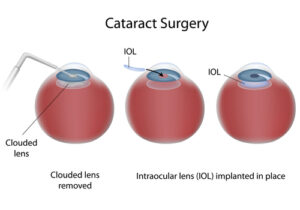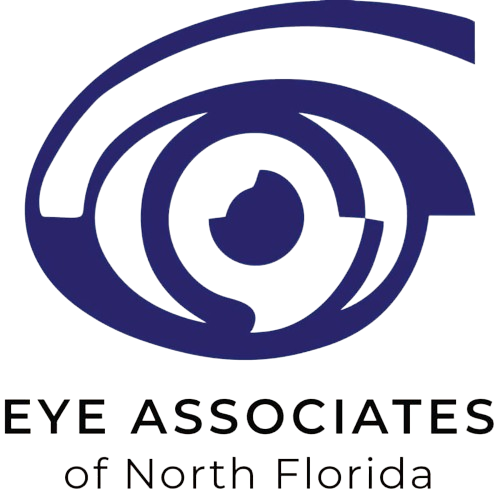Have Blurry, Distorted Vision? It May Be Due to Cataracts!

Refractive errors like nearsightedness, farsightedness, or astigmatism aren’t the only possible reasons for blurry vision. If you are fifty-five or older and your vision isn’t as clear as it used to be, a cataract could be to blame.
Cataracts are one of the most common causes of vision loss. Cataracts develop gradually over time, and blurry vision is just one of the ways they can affect your vision.

When you have a cataract, you don’t have to be stuck with unclear vision for the rest of your life. With a simple procedure, clear vision can be restored.
Keep reading to discover how your blurry, distorted vision may be due to cataracts!
What Is a Cataract?
A cataract is a clouding of the eye’s natural lens. The lens is usually transparent.
It is located behind the iris, the colored part of your eye. Light passes through the lens, and the lens focuses rays onto the retina to create clear images.

Age-related cataracts are the most common kind. Your lens contains structural proteins. These help the lens to bend and focus light.
Starting around your forties, these proteins begin to break down and form clumps in your lens, causing a cataract. This is a normal part of the aging process.
While age is the most significant risk factor for developing a cataract, it is not the only one. Cataracts can also develop after eye surgery, such as surgery to treat glaucoma.
They can also result from trauma to the eye, like a fall to the ground or an object striking the eye. Some conditions can increase your risk of getting a cataract.
These include diabetes and obesity. Medications like steroids can increase your risk as well. Smoking, heavy alcohol consumption, excessive exposure to sunlight, and high blood pressure are additional risk factors.
Finally, although rare, babies can be born with a cataract, which is called a congenital cataract.
What Are the Common Signs of a Cataract?
Cataracts develop gradually, so symptoms typically worsen over time. You may not even notice a difference in your vision when it’s in the early stages.
When related to age, cataracts typically develop in both eyes at similar rates. However, if a cataract is present in both eyes, one may affect your vision more significantly than the other.

The common signs of a cataract include:
- Blurry, distorted vision
- Glare
- Light sensitivity
- Fading or yellowing of colors
- Needing more light to read
- Difficulty seeing at night
- Double vision in one eye
- Frequent prescription changes
A cataract makes your vision appear blurry and distorted because it blocks light rays from passing through the lens. The clouded area prevents your eye from focusing light as it should, resulting in a blurry image.
Driving at night can become particularly difficult when you have a cataract. The glare from oncoming headlights can overwhelm your vision.
Many patients with cataracts find that they have to turn on additional lights in order to perform up-close activities like reading when this wasn’t necessary before. They may also need to keep updating their prescription, as their cataract worsens.
How Are Cataracts Treated?
When left untreated, a cataract can lead to total blindness. However, visual symptoms related to cataracts are treatable, and it doesn’t have to progress to that point.
Cataracts can be treated very successfully with cataract surgery. Being diagnosed with a cataract does not mean that you need to schedule cataract surgery immediately.
Since cataracts progress slowly over time, cataract surgery is not always necessary right away. It’s time to consider surgery when a cataract begins to have a more serious impact on your daily activities.

For example, maybe you no longer feel safe driving at night, or you can’t seem to read without straining in any lighting condition, no matter how bright. Cataract surgery may also be recommended if a cataract gets in the way of examining or treating another eye condition, like age-related macular degeneration or diabetic retinopathy.
The eye doctors at Eye Associates of Tallahassee consider your individual needs before recommending any particular course of treatment. A new prescription or some basic lifestyle changes, like turning on an extra light, may be enough to offset the effects of a cataract for the time being.
When you and your eye doctor agree that it’s time to get your cataract removed, it can be done with a simple procedure. During cataract surgery, your cataract surgeon will remove your clouded lens.
Then they will implant a clear, artificial lens, called an intraocular lens, or IOL. Premium lenses can allow you to see even better than you could before the cataract.
As common as cataracts are, cataract surgery is just as common. Every year, millions are performed in the United States alone.
With an excellent success rate, cataract surgery can get rid of your cataract for good and restore clear vision.
Are you interested in learning more about cataract surgery so you can experience clear vision once again? Schedule an appointment at Eye Associates of Tallahassee in Tallahassee, FL, today!







